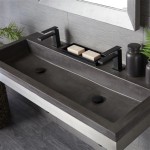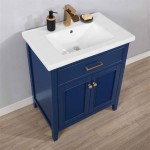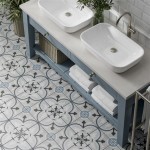Kitchen Sink in Bathroom: An Unconventional Choice
The decision to install a kitchen sink in a bathroom, while unconventional, is a choice some homeowners and builders make for various practical and aesthetic reasons. This article explores the motivations behind this choice, the advantages and disadvantages it presents, and the considerations involved in planning and executing such a bathroom design. Diverging from the standard bathroom sink can offer unique functionality and visual appeal, but it requires careful assessment of the space, plumbing requirements, and overall design coherence.
Traditionally, bathrooms are equipped with sinks designed specifically for personal hygiene tasks such as handwashing, teeth brushing, and shaving. These sinks are typically smaller and shallower than kitchen sinks. Kitchen sinks, on the other hand, are designed for tasks involving food preparation and dishwashing. They are usually larger, deeper, and constructed from materials resistant to food stains and scratches. The deliberate choice to incorporate a kitchen sink into a bathroom environment necessitates a thorough understanding of the differences between these fixtures and the implications for bathroom functionality.
Several factors can contribute to the decision to opt for a kitchen sink in a bathroom. These include aesthetic preferences, accessibility needs, and the desire for increased functionality within the bathroom space. The perceived visual appeal of a particular kitchen sink, its material, or its design can be a significant driver. Additionally, certain individuals may require larger or deeper sinks for specific hygiene needs or disabilities. Finally, incorporating a kitchen sink can create additional workspace within the bathroom, particularly in larger master bathrooms or shared family bathrooms.
Reasons for Choosing a Kitchen Sink in a Bathroom
One primary reason for selecting a kitchen sink for a bathroom is the enhanced utility it offers. The larger size and deeper basin of a kitchen sink provide more space for various tasks beyond basic handwashing. For example, it can be used for washing delicate clothing items, cleaning paintbrushes, or even bathing small pets. This increased functionality can be particularly beneficial in homes with limited laundry facilities or for individuals who prefer to perform certain tasks in the privacy of their bathroom.
Accessibility is another crucial consideration. Individuals with mobility limitations or disabilities may find a deeper kitchen sink more accessible than a standard bathroom sink. The increased depth can allow for easier reach and maneuverability, especially when using a wheelchair or other mobility aids. Furthermore, the added space around the sink can accommodate assistive devices or caregivers more comfortably. Therefore, a kitchen sink can be a practical and inclusive design choice for accessible bathrooms.
Aesthetic considerations also play a significant role in the decision-making process. Some homeowners simply prefer the look of a particular kitchen sink model over the available bathroom sink options. Kitchen sinks come in a wider variety of styles, materials, and finishes, allowing for greater customization and design flexibility. For example, a farmhouse-style kitchen sink can add a rustic charm to a bathroom, while a sleek stainless steel sink can contribute to a modern and minimalist aesthetic. The ability to express personal style and create a unique bathroom design is a compelling reason for choosing a kitchen sink.
Finally, practicality in a specific setting can dictate this design choice. In mudrooms with attached bathrooms or in recreational spaces like pool houses, a kitchen sink offers a robust and versatile option for clean-up. The ability to easily wash off dirt, mud, or pool chemicals makes a kitchen sink a practical solution in these high-traffic, high-mess areas. Its durability and resistance to stains and scratches also make it a more suitable choice than a delicate bathroom sink in such environments.
Advantages of Installing a Kitchen Sink in a Bathroom
The most apparent advantage of using a kitchen sink in a bathroom is its increased size and capacity. This allows for more comfortable and efficient completion of various tasks that would be cumbersome or impossible with a smaller bathroom sink. Washing large or bulky items, filling buckets, or even rinsing off gardening tools becomes significantly easier with the added space. This increased functionality can be a valuable asset, particularly in situations where utility and practicality are paramount.
Durability is another key advantage. Kitchen sinks are typically constructed from more robust materials than bathroom sinks, designed to withstand the rigors of daily use and exposure to various substances. Stainless steel, cast iron, and composite materials are common choices for kitchen sinks, known for their resistance to scratches, stains, and impacts. This added durability translates to a longer lifespan and reduced maintenance requirements, making a kitchen sink a more cost-effective option in the long run, especially in high-use bathrooms.
The wider range of styles and finishes available for kitchen sinks provides greater design flexibility. Homeowners can choose from a vast selection of materials, shapes, and colors to complement their overall bathroom design. From traditional farmhouse sinks to modern undermount sinks, the options are virtually limitless. This allows for greater personalization and the creation of a unique and visually appealing bathroom space that reflects individual tastes and preferences.
Finally, a kitchen sink can be more ergonomic for certain users. The deeper basin can reduce the need to bend over excessively, which can be particularly beneficial for individuals with back problems or mobility limitations. The added height of some kitchen sinks can also be advantageous for taller individuals who find standard bathroom sinks too low. By providing a more comfortable and accessible washing experience, a kitchen sink can improve the overall usability of the bathroom.
Disadvantages and Considerations
Despite the potential benefits, installing a kitchen sink in a bathroom also presents several disadvantages and considerations that must be carefully evaluated. One of the main concerns is the potential for the sink to overwhelm the space. Kitchen sinks are typically larger than bathroom sinks, and their size can make a small or cramped bathroom feel even smaller. Careful planning and measurement are crucial to ensure that the sink fits comfortably within the available space without obstructing movement or creating a sense of overcrowding.
Another consideration is the potential mismatch in aesthetics. Kitchen sinks are designed with a different purpose in mind than bathroom sinks, and their styling may not always complement the overall design of the bathroom. For example, a utilitarian stainless steel kitchen sink might look out of place in a luxurious spa-like bathroom. Careful consideration should be given to the sink's material, shape, and finish to ensure that it harmonizes with the existing décor and contributes to a cohesive aesthetic.
Plumbing requirements can also be a significant challenge. Kitchen sinks often have different plumbing connections and drain configurations than bathroom sinks. This can necessitate modifications to the existing plumbing infrastructure, which can be costly and time-consuming. It is essential to consult with a qualified plumber to assess the feasibility of installing a kitchen sink and to ensure that the plumbing is properly connected and functions efficiently.
Finally, cost is a factor to consider. Kitchen sinks can be more expensive than bathroom sinks, particularly those made from high-end materials or featuring specialized designs. The additional cost of plumbing modifications and installation can further increase the overall expense. Homeowners should carefully weigh the potential benefits of a kitchen sink against the associated costs to determine if it is a worthwhile investment for their bathroom.
In summary, the decision to install a kitchen sink in a bathroom is a complex one that requires careful consideration of various factors. While it can offer increased functionality, durability, and design flexibility, it also presents potential challenges related to space, aesthetics, plumbing, and cost. By thoroughly evaluating these aspects and consulting with qualified professionals, homeowners can make an informed decision that aligns with their needs and preferences.

Sinks For Bathroom Kitchen Bar And Laundry Rooms At Faucet Com

Farmhouse Sinks For The Bathroom Qualitybath Com Discover
:strip_icc()/102968818-d7d4e620c15c40a1b6dde19cbf7ea820.jpg?strip=all)
How To Choose A Kitchen Sink Fit Your Layout And Style

Pin On Toa

Brightly Colored Kitchen Sinks Door Sixteen
Kitchen Sink Guide Signature Hardware
Kitchen Sink Guide Signature Hardware

What To Know About Choosing The Right Size Kitchen Sink Remodeling 101 Remodelista

Pin On Contemporary Decorating Ideas

Ceramic Sink Vs Stainless Steel Lesso Blog
Related Posts







